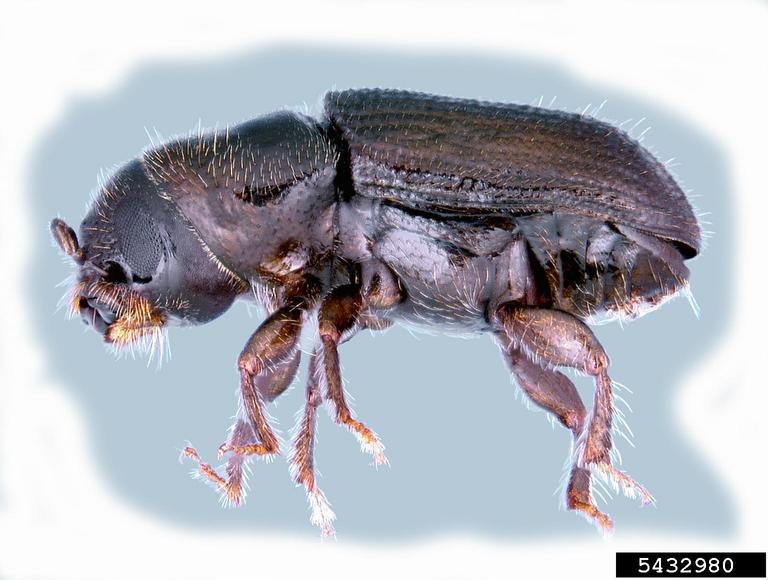Introduction
Southern pine beetle (Dendroctonus frontalis) is a small insect that is native to North America. The insect is considered one of the most destructive pests of conifers. It often targets pine trees, where it propagates quickly. Severe infestations are capable of decimating pine populations.
Distribution & Habitat
The range of southern pine beetle covers the southeastern United States, extending from Pennsylvania and New Jersey to Texas, and west to Arizona and New Mexico. Southern pine beetle has been reported in several northeastern states as well, including New York, and Massachusetts. Infestations are also common in Mexico, and Central America.
Hosts
In the southeastern United States, loblolly, shortleaf, pitch, pond, and Virginia pines are the insect’s preferred hosts. Pinus oocarpa and Pinus caribea are the primary hosts in Mexico, and Central America. During outbreaks, the beetle may infest all pine species. When infestations become extensive, the beetles may also feed on spruce and hemlock. Severely weakened pines are generally more prone to infestation.
Description
Young adults change color throughout their development. They initially appear yellowish-white, turning yellowish-brown to reddish-brown, and then dark brown to black as they mature. They are cylindrical in shape, with three pairs of short legs, and a rounded posterior. Male beetles have a distinct notch, or frontal groove. Females possess a broad, traverse ridge along the anterior. Mature adults measure 2 to 4 mm in length. The eggs are ovate in shape. They have a shiny appearance, and are pearly white in color. The larvae are crescent-shaped. They appear white, with a reddish-brown head. The pupae are white. They morph into callow adults, which are soft, and amber colored. As the cuticle hardens, the pupae darken in color.
Life Cycle
Beetle populations are often concentrated in forested locations. Beetle numbers often increase exponentially, causing outbreaks to occur, with healthy, vigorous pines infested and killed. Outbreaks of southern pine beetle generally occur every year within the insect’s range. The beetle passes through four stages during its life cycle: an egg stage, a larval stage, a pupal stage, and an adult stage. Most tree infestations are initiated in spring. Overwintering adults emerge from infested trees, and enter a dispersal phase, in which they seek out suitable hosts for oviposition. Once they have settled on a tree, the adult females release aggregation pheremones that attract the males. The males navigate to the host trees, and release their own pheremones, which further increases aggregation. As the beetles increase in numbers, the host is overcome, and successfully colonized.
The females initiate the infestation. They bore through the bark, and burrow into the cambial layer. The females generally infiltrate the host trees at the bark crevices. When trees are initially attacked, they produce resin, which may cause the beetles to be pitched out. The pitch tubes that form in the bark crevices may be white or yellow, depending on the tree species. As the resin seeps out of the tree, the males and females often work together to clear a path to the bark. Once they have done so, the females penetrate the bark, and begin constructing s-shaped egg galleries in the cambium. The eggs are laid in niches cut into the walls of the galleries. The males follow close behind the females, packing the galleries tightly with frass. The adults will sometimes create ventilation holes leading from the gallery to the bark surface. The eggs hatch three to nine days following oviposition. The newly hatched larvae burrow into the inner bark, constructing winding galleries perpendicular to the egg galleries they have emerged from. The larvae feed in the inner phloem, growing all the while. Soon, the larvae move into the outer bark, where they mature, and pupate. The larvae pupate for six to fourteen days, transforming into callow adults. Once the pupation stage is complete, the young adults shed the pupal skin, and emerge. They remain in the bark for six to fourteen days. During this period, the adults’ cuticle hardens, and darkens in color. The adults chew small, round exit holes in the bark, and vacate the tree. These holes may be observed on the bark surface following the beetles’ emergence. Upon leaving the host tree, many adults navigate to new trees, where they initiate new outbreaks. Adults often inoculate pines with blue stain fungi, which penetrate the sapwood. The blue stain fungi inhibit the tree’s vascular system, resulting in rapid tree mortality.
Southern pine beetle produces up to six generations per year. Multiple generations may overlap on infested trees in late spring, and summer. Once a tree has become fully colonized, the adults target adjacent pines. The continual propagation of the beetles, coupled with the pheremones produced by the adults, causes the infestation to spread, consuming any nearby trees. These expanding infestations are initially contained to one area, called the spot head. As the infestation enlarges, additional spot heads may develop. Large infestations may spread at a rate of 120 feet per day. Beetle dispersal is common in spring, but limited in summer. As temperatures decline in fall, the beetles may remain in the spot heads, or travel to individual trees where they reside through the winter months. The beetles may overwinter in all stages within a tree. Beetle development slows during winter. If temperatures rise in winter, the beetles will often resume activity, with some emerging from the host trees to feed. Beetles that emerge in winter may colonize unoccupied portions of the host tree.
Symptoms of Infestation
New infestations are characterized by the presence of reddish-white wood dust produced as the adults penetrate into the bark of the host. The boring dust often accumulates at the base of the tree, in bark crevices, and on the understory foliage. Adults may be observed removing resin from the pitch tubes. Pitch tubes may occur from ground level up to 60 feet high. As the larvae hatch, and commence feeding, the crown gradually becomes discolored, changing from green to yellow, before deepening to red. Eventually, the foliage turns brown, and is shed from the tree. A fading crown is symptomatic of a colonized pine, and typically indicates that the beetle is present.
Trees vacated by the adults feature numerous exit holes in the bark. White sawdust produced by wood-boring ambrosia beetles is often abundant at the base of vacated trees. The bark on infested trees becomes loose, and can be peeled away easily. When a section of the bark is removed, the s-shaped egg galleries are conspicuous, and the surface of the sapwood will have turned brown. Clerid beetles are often found in infested trees.
Management
- Southern pine beetle has numerous predators, parasitoids, and diseases that help to limit its populations. Thamasimus dubius is a major predator of the adults and larvae. Woodpeckers feed on the larvae, pupae, and callow adults during winter. Freezing temperatures, or temperatures exceeding 95°F can kill the eggs, and larvae.
- Funnel traps baited with host volatiles can be set out each spring during the beetle’s dispersal phase for detection, and monitoring.
- Symptomatic trees should be culled to reduce the proliferation, and spread of the adults.
- Thin dense stands to improve air circulation, and increase tree vigor. In urban settings, maintain a distance of at least 25 feet between mature pines.
- In spring, registered insecticides can be applied to trees of high value to prevent outbreaks from occurring.
- When planting, promote tree diversity. Select trees that are resistant to southern pine beetle infestation.
Photo courtesy of Erich G. Vallery, USDA Forest Service, Bugwood.org.


